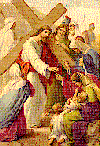
The Way of the Cross
Scripture and Prayers on the
Passion and Death of
Our Lord and Savior Jesus Christ
Source: The Rev. Thomas L. Weitzel
Evangelical Lutheran Church in America
.
INTRODUCTION
The Stations of the Cross combine art, sculpture and movement to recreate Christ's walk to Calvary within the walls of the church, allowing the faithful to make a "pilgrimage to Jerusalem" and be drawn closer to the Christ who walked there.
The stations tradition developed during the time of the Crusades (12-13th cent.). Their number and subject matter have varied widely, from as many as 30 to as few as five. The 14 of current practice first appeared in the 16th century and were fixed in 1731 by Pope Clement XII, consisting of nine gospel scenes and five scenes from popular tradition.
While many have found the stations from tradition questionable, I have chosen to include them all. These stations are like parables with a message, much as Jesus taught in parables. The falls of Christ (stations 3, 7, 9) while not scriptural, could well have occurred in fact, given his all night interrogation, scourgings and loss of blood. Theologically, the falls witness to the weight of our sin which crushed Christ. Jesus' encounter with Mary on the road to Calvary (station 4) simply expands on the same encounter at the crucifixion as recorded in John's gospel.
The woman wiping Jesus' face (station 6) likely derives from the veil with Christ's image (i.e., vera icon, true image, hence the name Veronica) which has been kept in the Vatican since the 8th century. Without debating the veil's authenticity, the station teaches that the true image of Christ occurs in our loving one another. To illustrate this, I have retitled the station and included the story of Jesus' anointing by the woman of Bethany which begins the Passion narrative in all four gospels. The five stations from tradition may be omitted if desired.
The Stations of the Cross are intended to be a devotion that is prayed and walked by one or more persons, traditionally on Fridays, and especially during Lent. The stations themselves may be as simple as black paper crosses and Roman numerals along the walls of the nave, or as elaborate as the great artistic renderings available in church supply catalogs.
NOTE FOR THE LEADER: At each station, announce the number of the station and its title, then read the parts marked (L:), following kneel/stand/bow rubrics as indicated. Allow a significant amount of time during the reflection at each station for personal prayer. Do not rush this reflection time. It is the heart of the devotion. A crucifer may lead the people from station to station, beginning and ending at the altar.
TLW, Good Friday 1992
The Stations Of The Cross: . .
OPENING PRAYER
Before the AltarTHE FIRST STATION
Jesus Is Condemned to DeathTHE SECOND STATION
Jesus Carries His CrossTHE THIRD STATION
Jesus Falls the First TimeTHE FOURTH STATION
Jesus Meets His Afflicted MotherTHE FIFTH STATION
Simon Helps Jesus Carry His CrossTHE SIXTH STATION
A Woman Offers Comfort to JesusTHE SEVENTH STATION
Jesus Falls a Second TimeTHE EIGHTH STATION
Jesus Meets the Women of JerusalemTHE NINTH STATION
Jesus Falls a Third TimeTHE TENTH STATION
Jesus Is Stripped of His ClothesTHE ELEVENTH STATION
Jesus Is Nailed to the CrossTHE TWELFTH STATION
Jesus Dies on the CrossTHE THIRTEENTH STATION
Jesus Is Taken Down from the CrossTHE FOURTEENTH STATION
Jesus Is Laid in the TombClosing Prayer
Before the Altar
.
Bible
Bible Calendar
Bible Characters
Bible Lands
Bible Stories
Children's Bible
Jerusalem Bible
King James Version
Leather Bible
NASB
New American Standard bible
New International Bible
New Jerusalem Bible
NIV
Referennce Bible
Saint Joseph
Study Bible